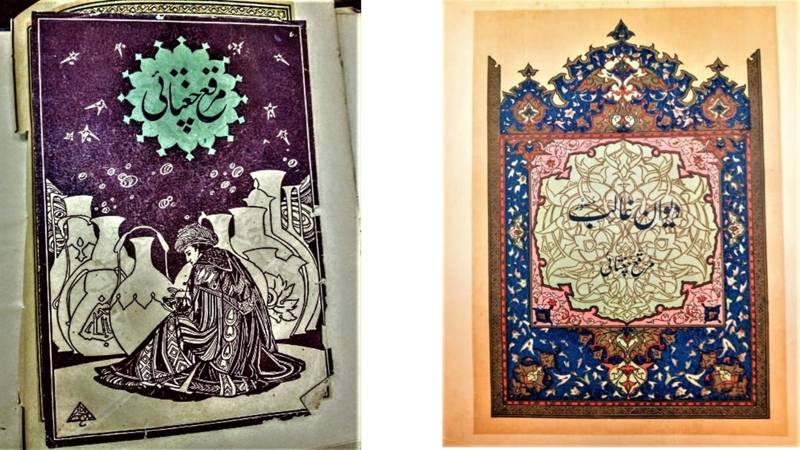
A Muraqqa is an album compiled in book form, containing several specimens of Islamic miniature paintings as well as Islamic calligraphy. Such an album was a popular item among the collectors from Islamic world, mostly from Persia, India and Ottoman Empire in the 16th century and later on. Owing to the higher costs in commissioning of miniaturists and calligraphers in production of artworks for such albums, the possession of these items was limited to only rulers and nobility. Even if it were not the commissioning of artists to produce artworks for Muraqqa, mere purchase of such artworks from a previous owner and owning one was impossible for a commoner, especially in the absence of printing technology in Islamic world.
Moving forward to the initial years of the 20th century, we see a 30-year-old emerging artist from Lahore, who would produce an illustrated book in the style of the 16th-century Muraqqa, lavishly illustrated, with calligraphy by a master calligrapher from Awadh. That book would be sold like hot cakes straight after its production, with many subsequent editions printed by different publishers later on. Even today, that book is in high demand among bibliophiles and art collectors.
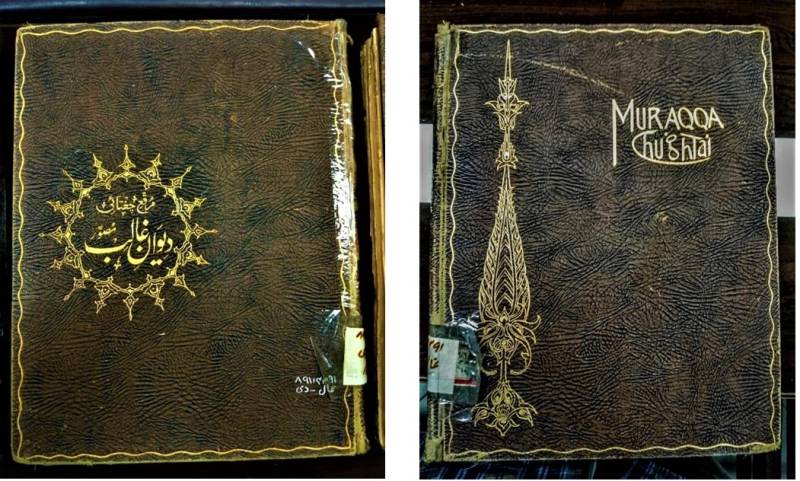
That book is the famous Muraqqa-i-Chughtai and was produced by Ustad Abdur Rahman Chughtai who became the national artist of Pakistan after 1947.
Muraqqa-i-Chughtai is chiefly an illustrated version of Mirza Asadullah Khan Ghalib’s collection of poetry called Diwan-e-Ghalib, in which side by side with some selected couplets, Chughtai has produced their artistic renditions in the form of water color illustrations. Originally published in 1928, the volume contains about 50 plates (lithographic prints) of Chughtai’s paintings in Perso-Mughal style, mounted on thick pages. Its introduction was written by Dr James H Cousins, an Irish writer and critic who settled in Madras, along with its foreword graciously penned by Dr Sir Muhammad Iqbal. Its “deluxe edition” was produced by Chughtai and his brothers themselves under the publisher title “Jahangeer Book Club, Chabuk Swaran, Lahore.”
About the publication of Chughtai’s paintings in such an illustrated book, Ms Dipa Donde is of the view, that contrary to the other successful painters of his time having royal patronage from princely state rulers and nobility, the publication of Chughtai’s works in print ensured that his works reached a wider circulation and received a larger viewership. As intended, the books received wider appreciation from different sections of Indian society, including the rulers of states like Hyderabad Deccan and Cooch Bihar, as well as from art critics and scholars and its copies were soon bought by them.
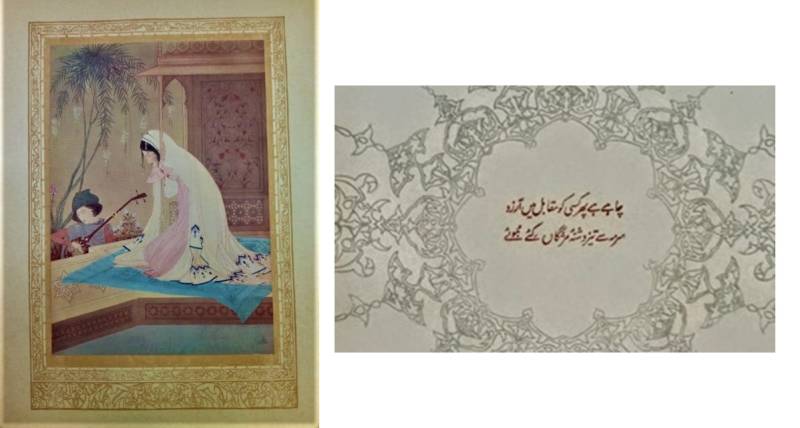
The story behind the idea of producing this magnificent book is an interesting one and goes back to 1924 (as mentioned in Chughtai’s Urdu article), when Abdur Rahman Chughtai was working as a teacher at the Mayo School of Arts, Lahore. After taking leave for some days from the college, when he rejoined, he was confronted by the principal Hugh Lionel Heath, who accused him of spending the whole time at the cinema instead of availing the actual reason for leave. Being jealous of his success at the recent Punjab Fine Arts Society’s exhibition, where almost all of Chughtai’s paintings were appreciated and sold for thousands, some colleague had shared such false information with the principal.
After a little argument, Chughtai went away and sent his resignation to the principal the next day. Shocked, the principal tried convincing him not to take such a drastic step. But he stuck to his decision and gave up his job. His family supported his decision, as it was a matter of their ego and self-respect. By that time, a colonial exhibition called “The British Empire Exhibition” was being held at Wembley Park, London in 1924. A good number of paintings were submitted by Chughtai for the exhibition. They were sold and received admiration and fame from international audiences. This gave him enough confidence to stay contented on being jobless for the moment and focus on promotion of his distinct style of painting that reflected the centuries of artistic heritage of Muslim artists of Mughal India, Iran and Central Asia.
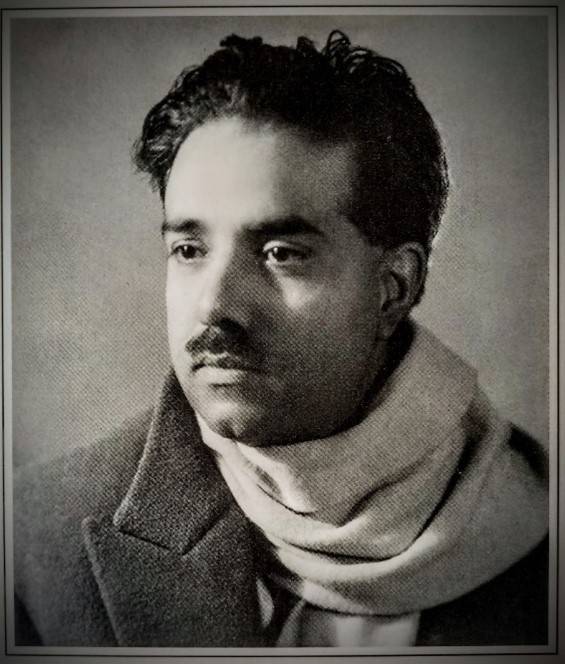
Chughtai had always been inclined towards cultural activities and was friends with a number of literary figures including Dr MD Taseer, with whom he would often have intellectual discussions at Chughtai’s home. One day, Chughtai’s younger brother Abdur Raheem was reading a poetic couplet of Ghalib, while looking at a painting by some famous artist. He exclaimed that the painting is exact interpretation of that couplet. When Taseer saw that, he also agreed, and opined that Chughtai should also render Ghalib’s verses in his own artistic style. Earlier than that, Chughtai had attempted to produce artworks on the poetry of Iqbal, so he replied that he had not studied Ghalib and that it was better for him to present the poetic works of Iqbal in artistic form first. But on their constant persuasion, he began creating some artwork, which after completion would come under frequent debates and discussions among his friends.
After some time, Chughtai had accumulated a number of paintings on Ghalib’s poetic themes. But he still had it in mind to produce an illustrated book on the poetry of Iqbal first. Unfortunately, that could not happen after some close friend of Iqbal raised the matter of royalties related to Iqbal’s works, that made Chughtai quit that plan for the time being. However, Abdur Raheem was so passionate about producing an illustrated manuscript on Ghalib’s poetry that he kept Chughtai going for it. By then, an art critic from Madras, G Venkatachalam, expressed his desire to acquire some of Chughtai’s paintings for the Maharani of Cooch Behar’s palace. He presented before Mr Venkatachalam the idea of an illustrated book and shared some proposals. Resultantly, the Maharani agreed to give Rs 5,000 for fifteen of the artist’s original paintings. According to Chughtai, the Maharaja of Patiala had also purchased a number of his paintings, making it easier for the artist to publish the planned book.
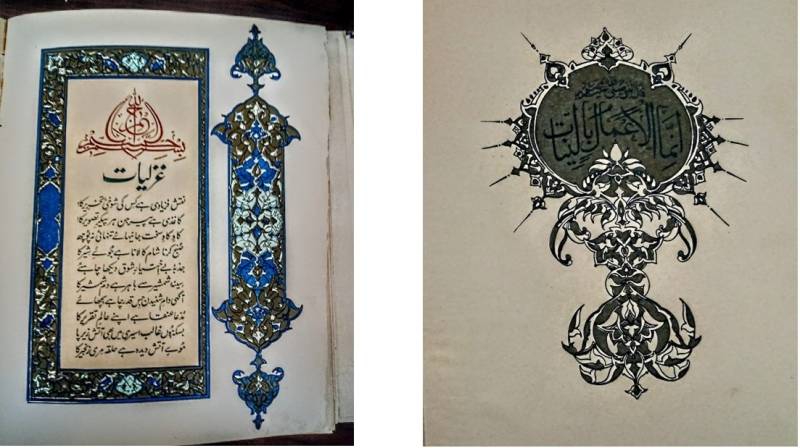
Soon, the publication of Muraqqa-i-Chughtai became the top priority of the artist and he found himself too busy to perform any task other than that. Having printing blocks of the pictures being made, the correction of the written matter in the book, having it scribed by a professional calligrapher, producing new designs for the adornment of the volume and binding of the book were among the many tasks in line. The quality of paper from the local market was not up-to-the-mark for Chughtai, so he had to order that of better quality from Europe. Even for the further funding of the project, he had to involve a local bank and pay back in instalments. When the matter of printing came up, he had to import a printing process from abroad, but it had some technical faults in it. It was sold, and a new one was bought, that needed electricity to work. For this purpose, Har Kishan Lal Gauba, a famous industrialist of Lahore, helped him get the electrical connection. The material used to make the cover of the manuscript was imported from Manchester, and the task for bookbinding was assigned to a local firm.
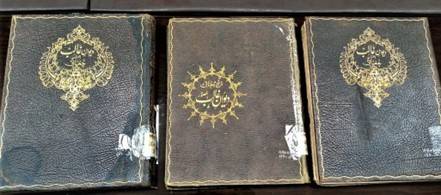
When the need arose for a good scribe to write Diwan-e-Ghalib’s main content, Chughtai and Dr Taseer didn’t leave any stone unturned to find a good calligrapher, and tried persuading many to write for the book, but nobody agreed. At last, Abdur Raheem himself found Munshi Asadullah, a calligrapher from Awadh who had settled in Lahore in 1890 and was a disciple of the teachers being descendants in line of the great calligraphy masters like Aaqa Abdur Rasheed Delmi and Mir Amaad-ul-Hasani. He understood Chughtai’s passion and devotion behind this project, so he contributed in this project through his skill with equal fervidness.
Here, Chughtai shows us that as opposed to the technology of today through which quality books can be easily composed and printed, in the 1920s it was quite a hectic task (in Urdu publication), that could not have been carried out without the client producing the printing blocks and providing printing machinery – all by himself. Among the team working with Chughtai, there was Abdur Raheem and his cousin Miraj-ud-Din, working on equal footing. The book for which they had begun working was not meant to cost more than six or seven rupees, but till now around 25,000 rupees had been spent on this project. So, it was suggested that the price should be increased. Thus, it was decided to produce a separate deluxe edition with the price of one hundred and ten rupees, and only 210 copies will be issued. People criticized Chughtai for the high price, but he was quite confident of his masterpiece and knew that lovers of art and poetry will buy it.
Shortly, through a local book dealer, the launch of deluxe edition was announced, and soon people from near and far began sending orders. All of those 210 copies were numbered and signed by Chughtai himself, and within no time, all of them were sold. Before his Muraqqa, no such beautifully illustrated and decorated book in colour existed in the Urdu language, but still art enthusiasts popped out from nowhere and bought this magnum opus of Chughtai. This book made its own special place in the world of art, and still holds it, as a pioneer of its own field. Besides the deluxe edition, a cheap edition was also published in large number, and can still be found in personal collections.
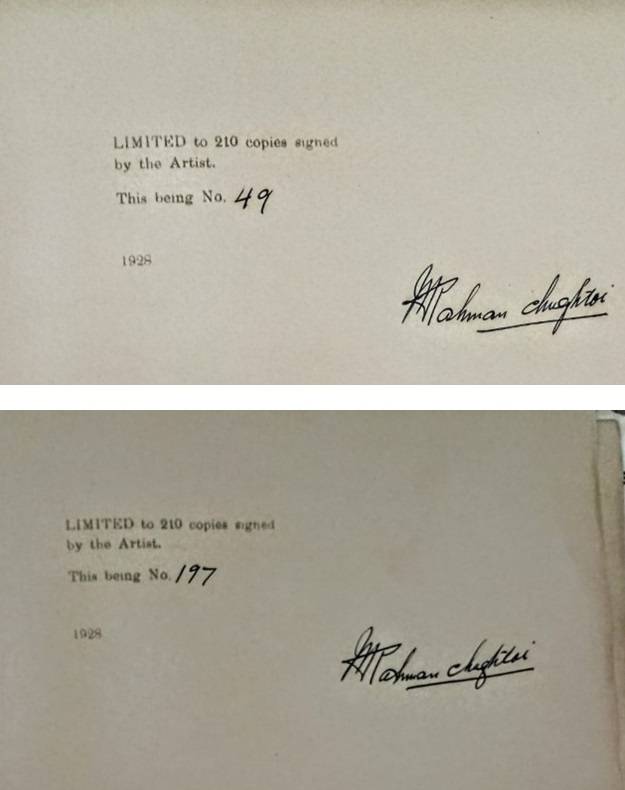
Though Muraqqa-i-Chughtai was republished many times in the subsequent years, but finding the original 1928 signed deluxe edition is a feat by itself. Regarding this, Arif Chughtai, the son of the artist, gives us the names of some of the possible owners of the deluxe edition.
- Mirza Ghalib: the first copy was respectfully placed at the tomb of Mirza Ghalib – that was stolen the next day.
- Dr Sir Muhammad Iqbal: he was presented with a copy, but he refused to accept it as an expensive object. When persuaded to keep it as a gift, he gave it to one of his students.
- The Nizam of Hyderabad Deccan: Chughtai’s brother Abdullah presented it to him.
- The Maharani of Cooch Behar: One copy was gifted to her for being an early patron of this project.
- The Lahore Museum: the curator had bought some copies for the museum collection.
- The Maharaja of Patiala, a patron of arts in Punjab.
- The Nawab of Bahawalpur: a copy of the deluxe condition is with his descendant.
- Nawab Ahmed Yar Khan Daultana (famous feudal lord from Punjab)
- Har Kishan Lal Gauba (famous industrialist from Lahore)
- Kallianjee Hormuz (an art collector from Bombay): he had especially purchased a copy in 1928.
To personally see the deluxe first edition signed copy of Muraqqa-i-Chughtai, the author of this piece went to the Lahore Museum Library, and was surprised to see three copies of the said book inside the locked cabinets. Being able to have them taken out and go through them was an honour in of itself.
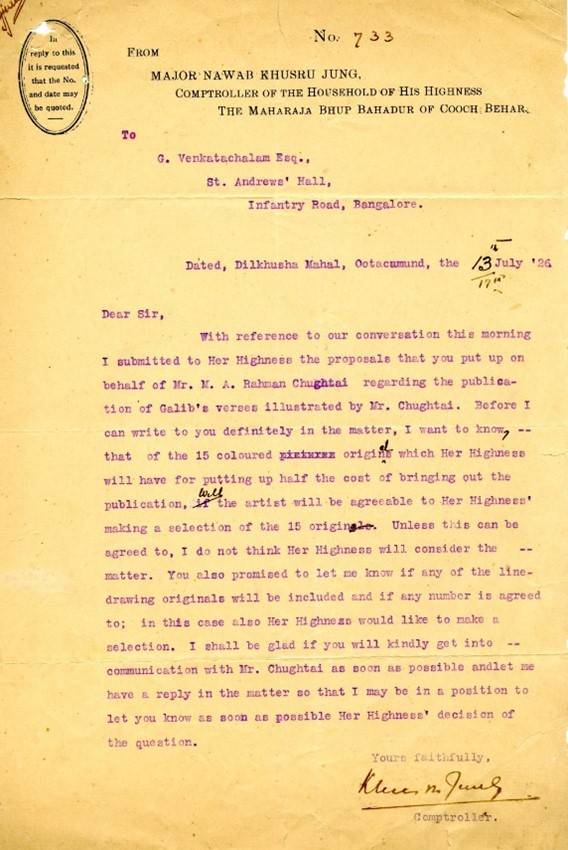
Copy of a letter sent in 1926 from the comptroller of the state of Cooch Behar to G Venkatachalam, mentioning the deal between Chughtai as an artist and the Maharani (Source: Chughtai Museum Blog)
Indeed, the beautiful pictures and the splendid calligraphy still make the reader awestruck with wonder, 96 years after its publication. Out of those three copies, two were the original numbered and signed copies, and one was a later edition published after 1947. The signed copies were numbered 49 and 197, and were in satisfactory condition, with almost all of the inner pages in their places and the binding slightly loosened with time. The later edition was published by Ahsan Brothers, Anarkali, Lahore.
Irrespective of time and space, Chughtai’s art always holds its value owing to its uniqueness and distinctiveness from the dominant Bengal School prevalent during Chughtai’s time, and his own amalgamation of Perso-Mughal art and the Japanese school. It all makes Chughtai’s art stand out compared to any other genre of painting even today. The same is the case with Chughtai’s Muraqqa-i-Chughtai that Iqbal calls “A unique enterprise in modern Indian painting and printing” in the book’s foreword.
Chughtai used the print medium to bring his art to maximum reach, and during his lifetime he has produced many other illustrated books like Naqsh-e-Chughtai (1935) and Amal-e-Chughtai (1968). Unlike his paintings and sketches that act as ambassadors of Pakistani art abroad, these illustrated books, that might be called “coffee table books” today, represent Pakistani art in an unrivalled manner. But, Muraqqa holds the importance as the first illustrated book in colour, published from India, especially by a Muslim artist. According to Abdur Rahman Chughtai, it is acting as an ambassador of the Urdu language, and has found its place in many of the world’s major centres of knowledge, libraries, museums and art studios. Its unique character and superb quality have brought Indian art and the Urdu language to an international stage.

